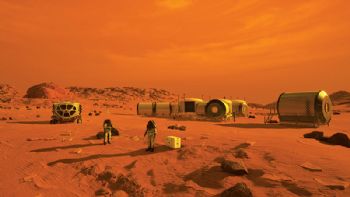
When a female astronaut first sets foot on the Moon in 2024, the historic moment will represent a step towards the goal of putting humans on Mars.
In the meantime, NASA’s Mars 2020 rover mission will also help future astronauts “brave the inhospitable landscape” of the Red Planet.
While the science goal of Mars 2020 is to look for signs of ancient life (it will be the first spacecraft to collect samples of the Martian surface, storing them in tubes that could be returned to Earth by a future mission), the vehicle also includes technology that will pave the way for the human exploration of Mars.
The atmosphere on Mars is mostly CO2 and extremely thin (about 100-times less dense than Earth’s), with no breathable oxygen; neither is there any water on the surface of Mars to drink.
Moreover, the landscape is freezing, and there is no protection from the Sun’s radiation, or from passing dust storms.
The keys to survival will be technology, research and testing; and when Mars 2020 launches in July 2020, the spacecraft will carry the latest scientific and engineering tools, which are coming together as the rover is built at NASA’s Jet Propulsion Laboratory in Pasadena, California.
Every landing on Mars offers a learning opportunity. With Mars 2020, that includes how the spacecraft’s heat shield and parachute perform in the planet’s atmosphere, and how well its radar can sense the approaching surface.
Sensors in the capsule that encloses the rover will study how it heats up and performs during atmospheric entry.
These ‘Mars Entry, Descent and Landing Instrumentation 2’ sensors could help engineers improve their landing designs for big payloads — such as astronaut equipment and habitats.
Landing this rover will give NASA (
www.nasa.gov) more experience of putting a heavy spacecraft on the surface of Mars.
The challenge of landing in the thin Martian atmosphere increases with mass, and the first crewed spacecraft will be ‘titanic’ by comparison, although Mars 2020 has a guidance system — Terrain Relative Navigation — that will help to ensure safer landings.
This works out where the spacecraft is headed by taking camera images during the descent and matching landmarks in them to a pre-loaded map; if the spacecraft drifts toward dangerous terrain, it will divert to a safer landing target.